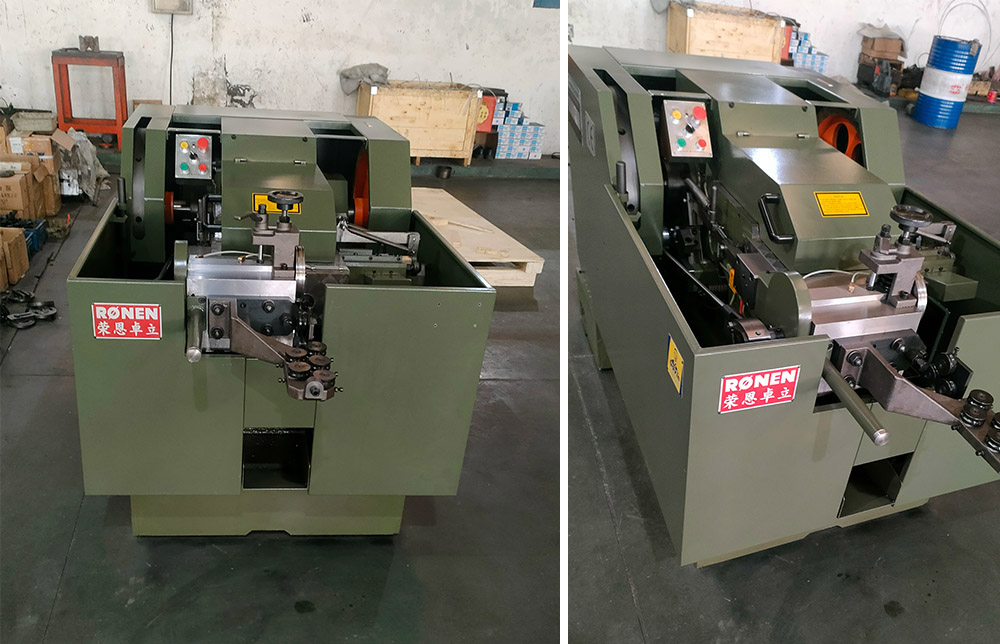
The rivet making machine is specifically designed to produce various types of rivets. First, the metal wire is fed into the machine, which is then cut into small sections of a fixed length. Next, it is pressed through a mold to shape one or both ends of the wire into the head shape of a rivet.
The rivet making machine is specifically designed to produce various types of rivets. First, the metal wire is fed into the machine, which is then cut into small sections of a fixed length. Next, it is pressed through a mold to shape one or both ends of the wire into the head shape of a rivet.
Product Parameter (Specification)
|
Model |
Unit |
WH-NF 11B-6S |
WH-NF 14B-6S |
WH-NF 19B-6S |
WH-NF 24B-6S |
WH-NF 33B-6S |
WH-NF 41B-6S |
|
Forging Station |
NO. |
6 | 6 | 6 | 6 | 6 | 6 |
|
Across Flats of Nut |
mm |
5.5-12.7 |
10-17 |
14-22 |
17-26 |
24-33 | 30-41 |
|
Suitable Hex Nut |
DIN |
M3-M6 |
M6-M10 |
M8-M14 |
M10-M18 |
M16-M22 |
M20-M27 |
|
Cut-off Dia |
mm |
11 | 16 | 19 | 24 | 31 | 40 |
|
Dies Pitch |
mm |
50 | 60 | 80 | 100 | 140 | 165 |
|
Forging Power |
Ton |
60 | 90 | 135 | 230 | 360 | 450 |
|
Main Motor |
HP |
15 | 20 | 50 | 75 | 150 | 200 |
|
Lubrication Motor |
HP |
1.5 | 1.5 | 1.5 3 | 1.5 3 | 3 | 3 |
|
Installed Quantity |
SET |
(1) |
(2) |
(1)(1) |
(1)(1) |
(2) |
(2) |
|
Lubricant |
L | 700 | 1000 | 1200 | 1700 | 1900 | 2200 |
|
Approx Weight |
Ton |
4.5 | 8 | 14 | 25 | 45 | 72 |
The features of the rivet making machine are quite obvious. The mold replacement is very convenient. To make different shapes of rivets, just change the mold set. For example, from round heads to flat heads. The impact force of this machine is sufficient. Whether it is aluminum, copper or iron materials, it can press out regular heads without any cracking or deformation.

Product details
The rivet making machine mainly uses the cold heading process to transform wire into solid rivets. This process involves feeding the wire, straightening it, cutting it into precise blanks, and then shaping the rivet head. The machine uses high pressure, using a punch to extrude and cut one end of the blank in the mold cavity. The cold heading process causes the metal to shift, thereby forming the characteristic shape of the rivet head without the need to heat the material.
The machine first feeds the wire rod (usually made of steel, aluminum or copper alloy) into the straightening mechanism to eliminate any bends. Then, the precision shearing machine cuts the straightened wire into billets of specific lengths. These uniformly sized billets are the raw materials before entering the cold heading section (for forming the rivet heads), and they are of crucial importance.
Many rivet making machines are equipped with a trimming station immediately after the upsetting process. This step can remove the small burrs or sharp edges formed at the edge of the new rivet head (the excess metal squeezed out between the punch and the die). Trimming ensures that the rivet head has a clear outline and a consistent diameter, which is crucial for proper installation and appearance.